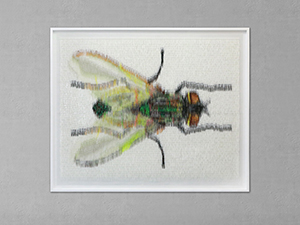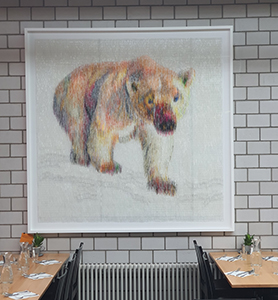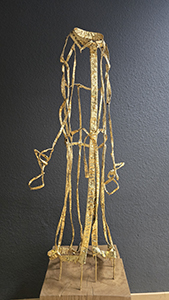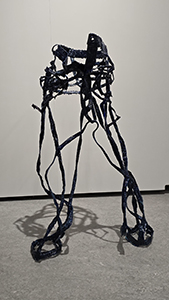
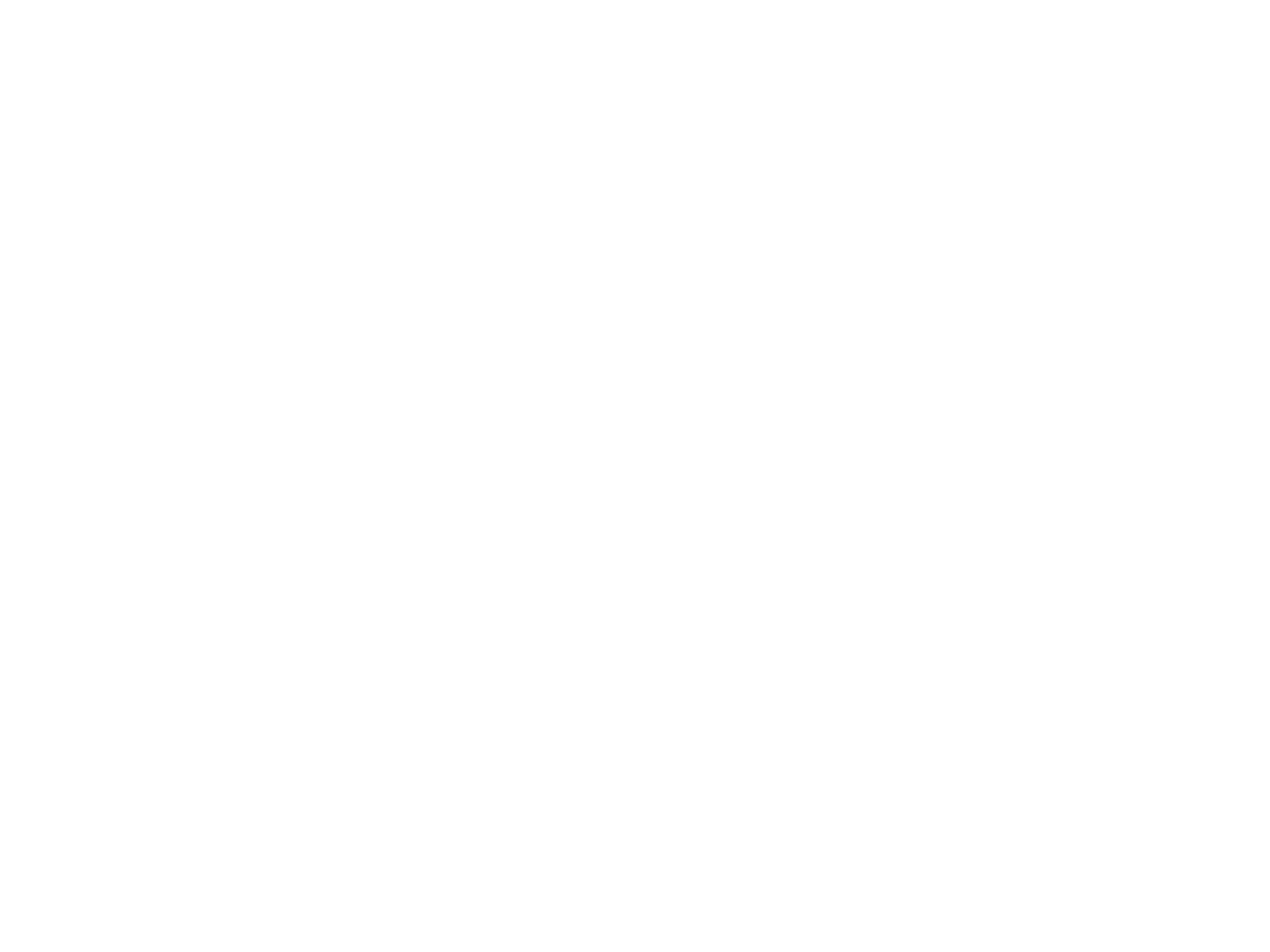
Earthly Things – Ghostly Matters
Vilija Litvinaite
My artistic practice deals with everyday phenomena. Questions are raised about the communication of the unspoken, the hidden and the secret.
My ways of thinking represent the collision of two worlds: communist anti-materialism and capitalist excess in a performance-oriented environment.
When I came to Switzerland in 1998, Lithuania was just beginning to orient itself towards the West. I did not witness the progressive transformation and therefore I miss the successive transitions from one world to the other. I try to create these connections through my artistic work.
My aim is not to find simple answers, but rather to open up spaces for reflection: In the handbags series, I tried to make the invisible visible and abstract it at the same time. Creating paper from old clothes leads to a deconstruction that takes a new look at the familiar and allows the material to transform itself further.
In my work with the dress seams, I was concerned with the role of women in society; I see the dress seams as a symbol of the distribution of roles.
Craft and a sensitivity for materiality are very important to me. I learn techniques such as papermaking or material printing in order to find new sculptures or images.
Meine künstlerische Praxis beschäftigt sich mit Alltagsphänomenen. Dabei werden Fragen nach der Kommunikation des Unausgesprochenen, des Verborgenen und Geheimen gestellt.
Meine Denkweisen stellen die Kollision zweierlei Welten dar: der kommunistische Antimaterialismus und der kapitalistische Überschuss in einem leistungsorientierten Umfeld.
Als ich im Jahr 1998 in die Schweiz kam, begann Litauen gerade erst, sich westlich zu orientieren. Die fortschreitende Wandlung habe ich nicht miterlebt und somit fehlen mir die sukzessiven Übergänge von einer in die andere Welt. Über meine künstlerische Tätigkeit versuche ich diese Verbindungen zu schaffen.
Dabei geht es mir nicht darum, einfache Antworten zu finden, sondern eher darum, Reflexionsräume aufzutun: In der Serie mit den Handtaschen habe ich versucht, Unsichtbares sichtbar zu machen und gleichzeitig zu abstrahieren. Das Papierschöpfen aus alten Kleidern führt zu einer Dekonstruktion, die einen neuen Blick auf das Bekannte wirft und das Material sich weiterverwandeln lässt.
In der Arbeit mit den Kleidernähten beschäftigte mich die Rolle der Frau in der Gesellschaft, die Kleidernähte verstehe ich als Symbol der Rollenverteilung.
Das handwerkliche Arbeiten und eine Sensibilität für die Materialität haben für mich einen hohen Stellenwert. Ich eigne mir Techniken wie das Papierschöpfen oder den Materialdruck an, um damit zu neuen Skulptur- oder Bildfindung zu gelangen.
Vilija Litvinaite, Animal Dominus, 2025, and Quick Fashion, 2024. Installation views
Animal Dominus, 2025
On display are two works from a series of thirteen: a polar bear, a fly. Two creatures from opposite worlds – connected by material and message. Both formed from thousands of cable ties, the plastic that clasps the earth like invisible shackles.
For me, animals have the same right to be here as we do. But humans have occupied almost every place, polluted the last spaces, filled the seas and skies with plastic.
Cable ties fix. They bind. In Animal Dominus, they form the bodies of creatures that tower above any hierarchy. The animal is not diminished here, not subordinated. It is at the center - like God in frescoes, like a judge, like a truth that we have suppressed for too long.
I was inspired by the philosopher Donna Haraway, who radically questions the usual orders. She talks about companion species. Humans and animals, plants, even technologies: they all live in a network of co-dependency. There is no life that is self-sufficient. Every existence is co-existence.
This series asks: Who really rules? Man? God? The system? Or life itself - indivisible, equal, in all its forms?
Animal Dominus, 2025
Gezeigt werden zwei Werke aus einer Reihe von dreizehn: ein Eisbär, eine Fliege. Zwei Wesen aus entgegengesetzten Welten – verbunden durch Material und Aussage. Beide geformt aus tausenden Kabelbindern, jenem Plastik, das die Erde umklammert wie unsichtbare Fesseln.
Für mich haben Tiere das gleiche Recht, hier zu sein wie wir. Doch der Mensch hat fast jeden Ort besetzt, die letzten Räume verschmutzt, Meere und Himmel mit Plastik gefüllt.
Kabelbinder fixieren. Sie fesseln. In Animal Dominus formen sie Körper von Lebewesen, die jede Hierarchie überragen. Das Tier wird hier nicht verkleinert, nicht untergeordnet. Es steht im Zentrum – wie Gott in Fresken, wie ein Richter, wie eine Wahrheit, die wir zu lange verdrängt haben.
Inspiriert hat mich die Philosophin Donna Haraway, die die gewohnten Ordnungen radikal in Frage stellt. Sie spricht von Companion Species – Begleiter-Spezies. Menschen und Tiere, Pflanzen, selbst Technologien: Sie alle leben in einem Netz von Ko-Abhängigkeit. Es gibt kein Leben, das sich selbst genügt. Jede Existenz ist Mit-Sein.
Diese Serie fragt: Wer herrscht wirklich? Der Mensch? Gott? Das System? Oder das Leben selbst – unteilbar, gleichwertig, in all seinen Formen?
Quick Fashion, 2025
Clothing is more than just fabric. It is our second skin, a woven sign of our identity. “Clothing changes our view of the world - and the world’s view of us,” wrote Virginia Woolf. Every thread carries stories, memories, gestures.
Georg Simmel called fashion a game between conformity and segregation – a mirror of our longing for belonging and individuality. In quick fashion, however, this game is in danger of breaking down: Clothing loses its language, its soul, its value.
The seams are like lines that trace the body – a framework of memories and projections. What remains is not a completed form, but an open skeleton that simultaneously unites body and emptiness, material and absence.
Roland Barthes described clothing as a language. In these works, it appears reduced to its grammar: the seam, the line, the trace. Just as bones carry the body, the seams carry the idea of the garment – an outline that guides our gaze and makes the invisible visible.
These silhouettes are both presence and absence: a dress that has already lost the body, yet retains its trace.
Quick Fashion, 2025
Kleidung ist mehr als Stoff. Sie ist unsere zweite Haut, ein gewebtes Zeichen unserer Identität. „Kleidung verändert unsere Sicht auf die Welt – und die Sicht der Welt auf uns“, schrieb Virginia Woolf. Jeder Faden trägt Geschichten, Erinnerungen, Gesten.
Georg Simmel nannte Mode ein Spiel zwischen Anpassung und Absonderung – ein Spiegel unserer Sehnsucht nach Zugehörigkeit und Individualität. In der Quick Fashion aber droht dieses Spiel zu zerbrechen: Kleidung verliert ihre Sprache, ihre Seele, ihren Wert.
Die Nähte sind wie Linien, die den Körper nachzeichnen – ein Gerüst von Erinnerungen und Projektionen. Was bleibt, ist keine vollendete Form, sondern ein offenes Skelett, das zugleich Körper und Leere, Stoff und Abwesenheit vereint.
Roland Barthes beschrieb Kleidung als eine Sprache. In diesen Werken erscheint sie reduziert auf ihre Grammatik: die Naht, die Linie, die Spur. So wie Knochen den Körper tragen, tragen die Nähte die Idee des Kleidungsstücks – ein Umriss, der unseren Blick führt und das Unsichtbare sichtbar macht.
Diese Silhouetten sind zugleich Präsenz und Abwesenheit: ein Kleid, das den Körper schon verloren hat, und doch seine Spur bewahrt.
